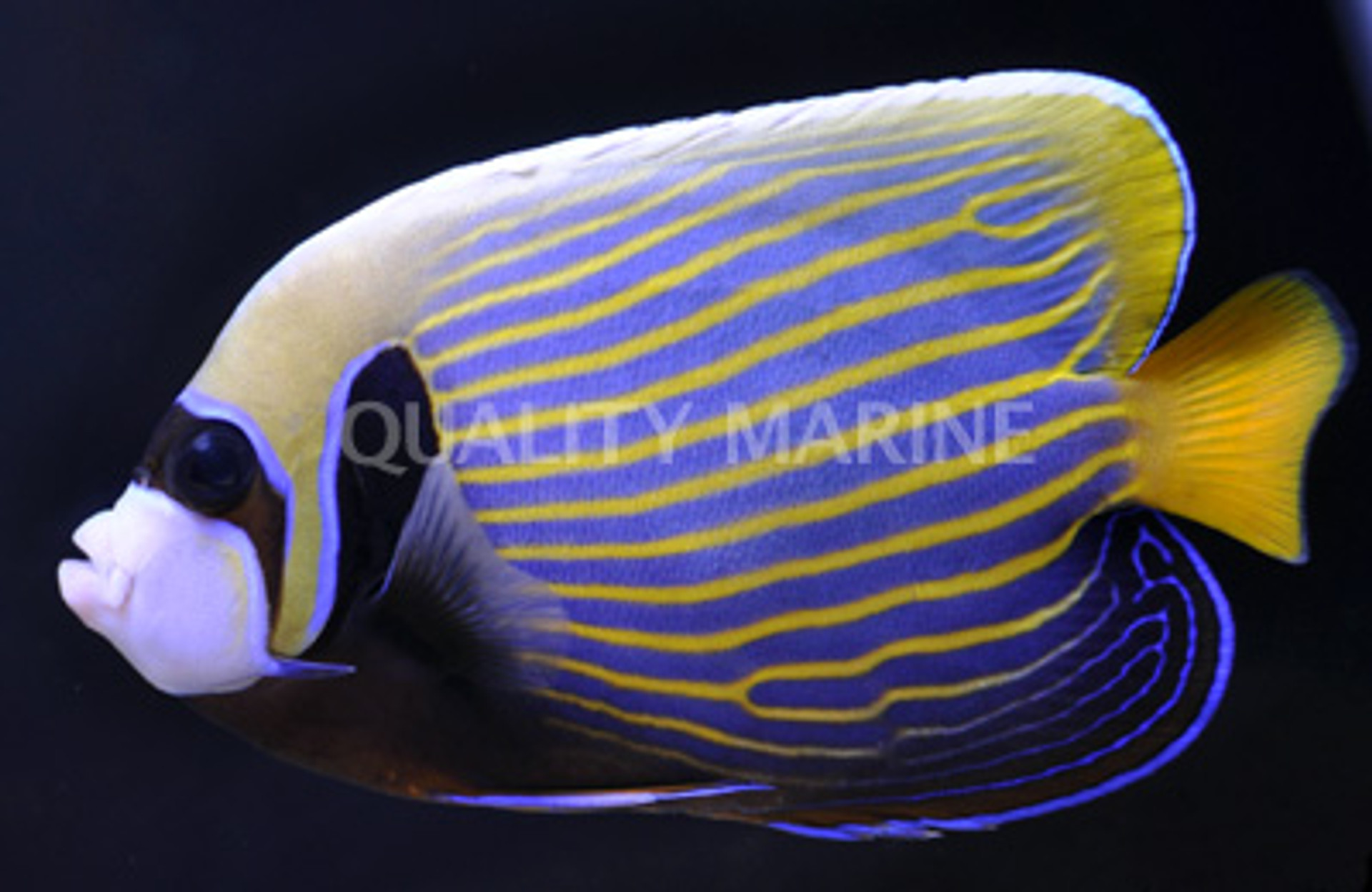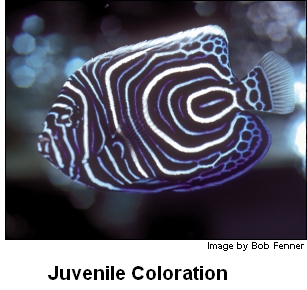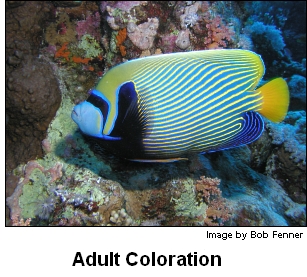Emperor Angelfish

Scientific name: Pomacanthus imperator
Common name: Emperor Angelfish, Imperator Angelfish, Imperial Angelfish
Taxonomy
Class: Actinopterygii
Order: Perciformes
Family: Pomacanthidae
Genus: Pomacanthus
Species: imperator
Description
The Emperor Angelfish (Pomacanthus imperator) is a beautiful and well known species which adapts well to captivity. Their interesting characteristics and personality make them fascinating aquarium inhabitants. Like many other members of its family, the Emperor Angelfish exhibits juvenile coloration and markings which are strikingly different as compared to the adult.
The juvenile appearance is comprised of a dark blue background with a series of fine blue and white stripes which are oriented vertically near the head and begin to form concentric circles near the rear of the body. No other juvenile angelfish species shows this pattern of concentric circles, and it is a diagnostic character for distinguishing the Emperor from other related species. At the dorsal and anal fins, these stripes form a network of small circles.
The appearance of the adult is nearly identical in body form but is entirely different in coloration and markings. Most of the body is marked with horizontal yellow stripes on a bright blue background. It is not uncommon for some stripes to split into two as they approach the rear of the fish. The facial markings are arranged into a blue-black eye mask and a white area surrounding the mouth and opercular spine. The rear portion of the dorsal fin as well as the caudal fin is generally yellow or orange (approaching red in some individuals). Large specimens may develop a trailing dorsal filament which tapers to a point.
The subadult is an individual in transition from juvenile to adult. Juveniles will begin to show this transition by a lightening of the color at the dorsal fin and upper body. The vertical and concentric stripes of the body will begin to break apart and then merge to form the eventual horizontal striping. During this transition, the markings may appear to be jumbled or disorganized. During the transition to adulthood, the fish will acquire the colors of yellow, orange and red.
The Emperor has a generally uniform appearance across its geographic range. Regional color variation is usually limited to the dorsal and caudal fin as being either yellow or orange. Adult coloration is especially vivid in individuals from East Africa and the Red Sea. Maximum size is about 16" (40 cm). Their lifespan is reported to be at least 15 years. As a conspicuous and showy reef inhabitant, this angelfish earns its name as the Emperor.

Natural Habitat and Ecology
The Emperor Angelfish's range is widespread from the Central Pacific all the way into the Indian Ocean and Red Sea. Coral reefs are the typical habitant with juveniles preferring the shelter of shallow reefs and adults tending to occupy deeper areas with caves and large prominent coral formations. The social structure of this angelfish is that of a harem, but pairs and loners are most often observed. Juveniles are normally solitary. Adults are aggressively territorial towards their own and other large angelfish species. The adults are generally tolerant of the presence of juveniles and it is theorized that this may explain the underlying function of the different appearances.
The transition from juvenile to adult may occur rather rapidly. Many individuals are beginning to show signs of a change at about 4" length, while others may still be showing juvenile coloration at over 6". The size and age of the transition to mature appearance may be dependant upon the existing angelfish population of the local reef in which the fish has taken up residence.
This angelfish feeds on a variety of benthic organisms with some emphasis on sponges and tunicates. If agitated, the Emperor is capable of making a distinct audible thumping sound. Sometimes a rapid series of thumps will be produced creating a sound like a brief drum roll or rattle.
Although this species is rather common throughout its range, local populations may be severely depleted or extirpated by overexploitation for the marine ornamental trade. The Emperor Angelfish has been a very popular and valuable aquarium fish for decades and many reefs of the Philippines and Indonesia no longer have viable populations as a result of long-term overharvesting. A proper collection management plan allows for the controlled harvest of some individuals while maintaining a robust breeding population. But the worldwide trend towards reef aquarium keeping may be working in the favor of wild stocks. Demand for this angelfish is reduced when many aquarists have chosen to maintain live invertebrates which these fish often find as irresistible food items.

Aquarium Care
The Emperor Angelfish is a hardy species and will thrive in most aquarium situations given certain requirements of nutrition, water quality and space. Once established in the aquarium, most are not fussy about eating whatever is offered to them. A variety of vitamin-enriched frozen and dried foods should be given. The small juveniles should be fed at least twice per day. Large individuals have an amazing capacity for food and are capable of swallowing whole krill. This fish will sometimes dominate other fishes during feeding time and so it may be necessary to ensure everyone gets enough to eat. It would be risky to keep more than one Emperor per aquarium based on their known territorial nature which develops as they mature. Many aquarists are able to observe a juvenile change to subadult and then to full adult in the home aquarium. The transition is often complete in less than a year. Emperors grow quite large and it may be best if they eventually are housed in at least 200 gallons as they mature.
Besides the thumping noises, the Emperor has another unusual behavior. When threatened, this species may turn on its side and hover horizontally just above the bottom. Inexperienced aquarists may initially and mistakenly interpret this behavior as being the last dying moments of their fish or some other terrible thing.
When purchasing an Emperor Angelfish, the aquarist should look for an engaging and curious disposition and a good interest in food. Take close notice of the dark skin areas which will help in observing for infections which may appear as tiny white spots or opaque film. Note that the naturally blotchy coloration of the transitional and subadult can appear as disease to the inexperienced eye. This species seems to be prone to acquiring head and lateral line erosion (HLLE) in captivity. This is best prevented by providing high water quality and feeding a good variety of vitamin-enriched foods. Although they become tolerant of a range of water quality, optimal conditions should be provided to maintain optimal health.

The Emperor Angelfish is the prized showpiece in any marine aquarium. Their impressive appearance and distinctive personality have made them an iconic favorite among the marine ornamentals.